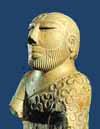An overview of history
The following overview was presented by Khurram Ali Shafique in Iqbal: Tashkeeli Daur (2009). It is an attempt to classify history according to the underlying concepts of the Republic of Rumi
Prehistory:
From the appearance of human being on this planet
to the beginning of civilization. Quranic figure: Adam.
Other: Vedanta
c.5000
BC - c.2000 BC: From the beginning of civilization
to the advent of Abraham. Quranic figure: Noah. Other:
development of art and music
c.2000
BC - c.1400 BC: From the advent of Abraham to the
birth of Moses. Quranic figure: Abraham. Other:
development of literature
c.1400
BC - c.600 BC: From Moses to, roughly, the sacking
of Jerusalem by Nebuchednezzar. Quranic figure: Moses.
Other: Gautama Buddha
c.600
BC - 4 BC: Roughly from Cyrus the Great to the birth
of Jesus Christ. Quranic figure: Zulqarnayn (possibly Cyrus
the Great). Other: Zarathustra
c.4
BC - 570: From Jesus Christ to the birth of Prophet
Muhammad. Quranic figure: Jesus
Since
570: Birth of the modern world with the advent of
Prophet Muhammad (peace be upon him). Subsequent periods may be
seen as subdivisions of this age. Quranic figure: Prophet
Muhammad
750 - 1258: Five centuries of Abbasid rule from 750 to 1258, when the legacy of Persian statecraft was Islamized in order to discover new horizons in science, learning and religious tolerance. Mode of Sufism: personal
1258
- 1747: Five centuries from 1258 to 1747, dominated
by "gunpowder empires" (Chinese, Ottoman, Safavid, Mughal,
European) directly or indirectly inspired by the model of Kubla
Khan. Mode of Sufism: institutional
Since 1747: Since
the accession of Ahmad Shah Abdali in Afghanistan in 1747, the world
has been dominated by nation states in search of democracy. Mode
of Sufism: social
|
With . |

 The
Age of Inquiry
The
Age of Inquiry
 The
Age of Discovery
The
Age of Discovery
 The
Age of Transcendence
The
Age of Transcendence
 The
Age of Freedom
The
Age of Freedom
 The
Age of Action
The
Age of Action
 The
Age of Expansion
The
Age of Expansion
 The
Age of Creation
The
Age of Creation
 Persian
Revival
Persian
Revival
 Chinese
Revival
Chinese
Revival Afghan
Revival
Afghan
Revival